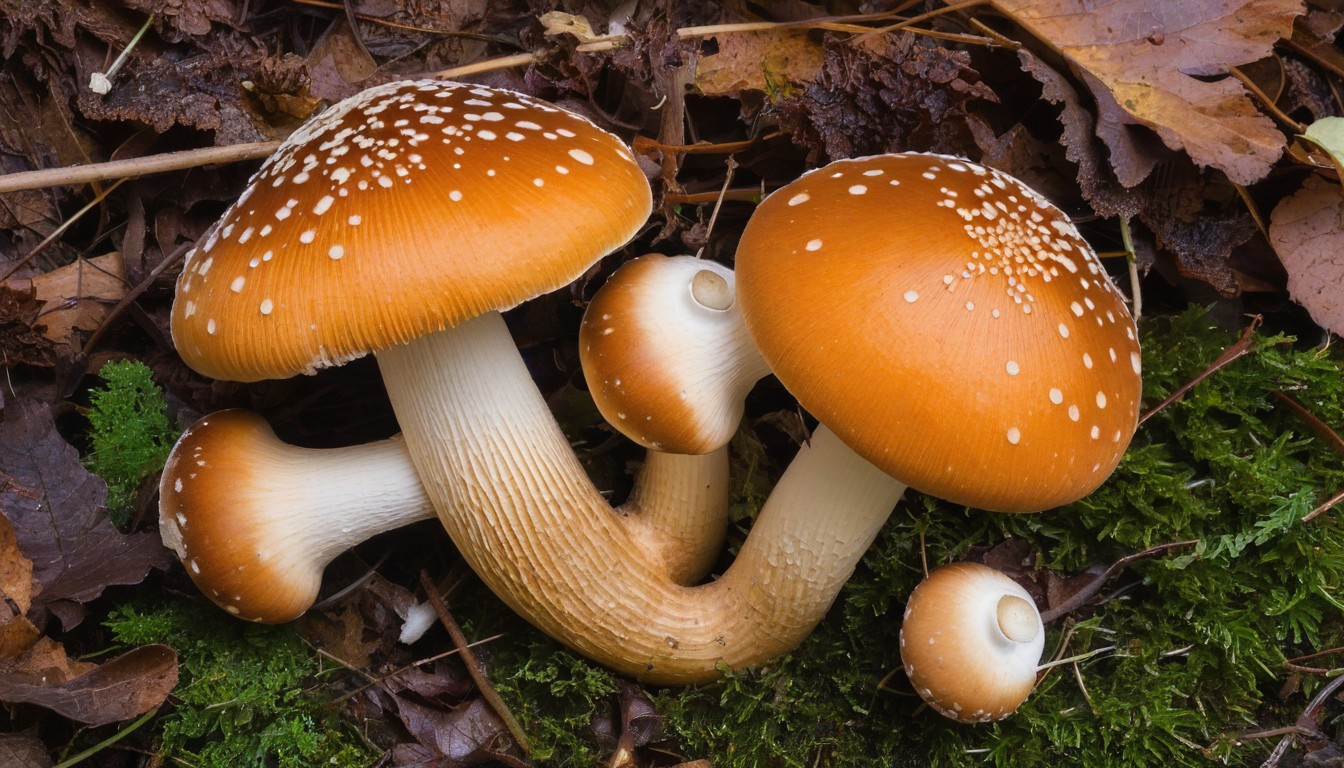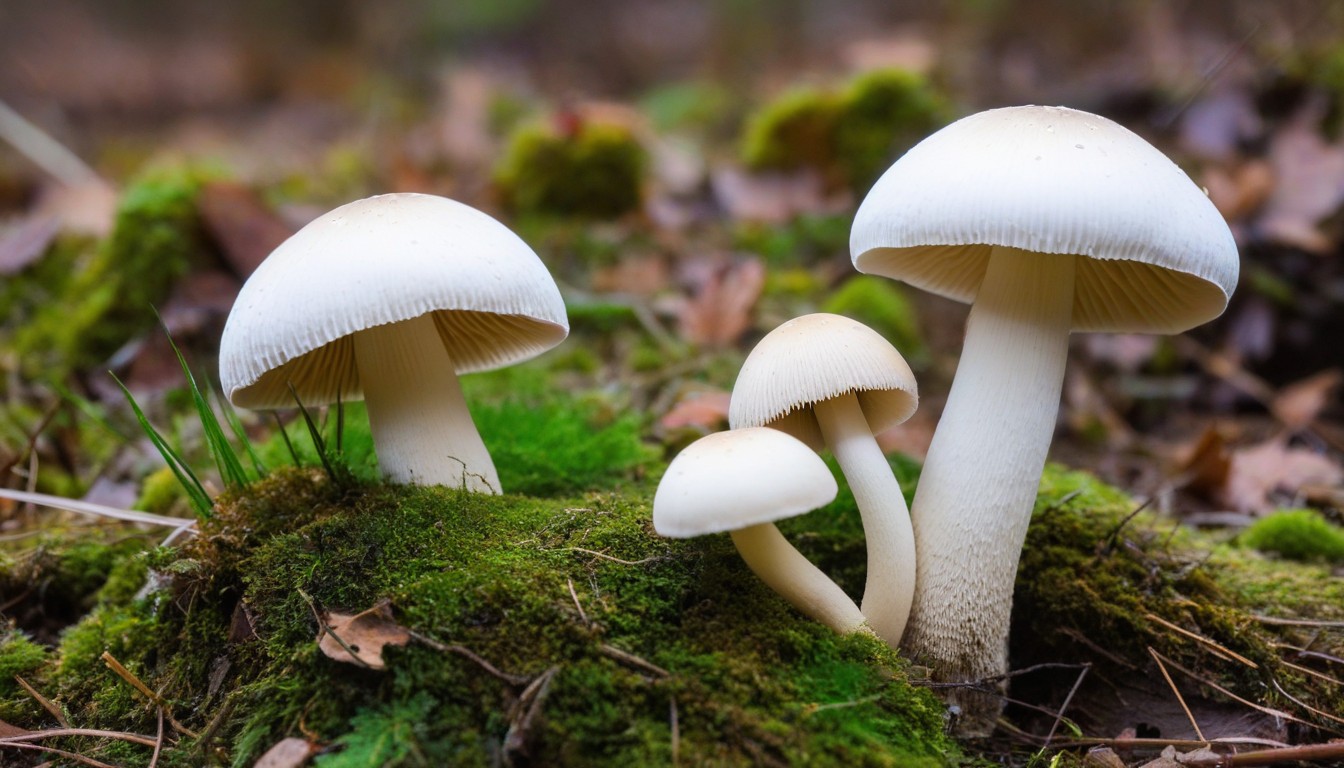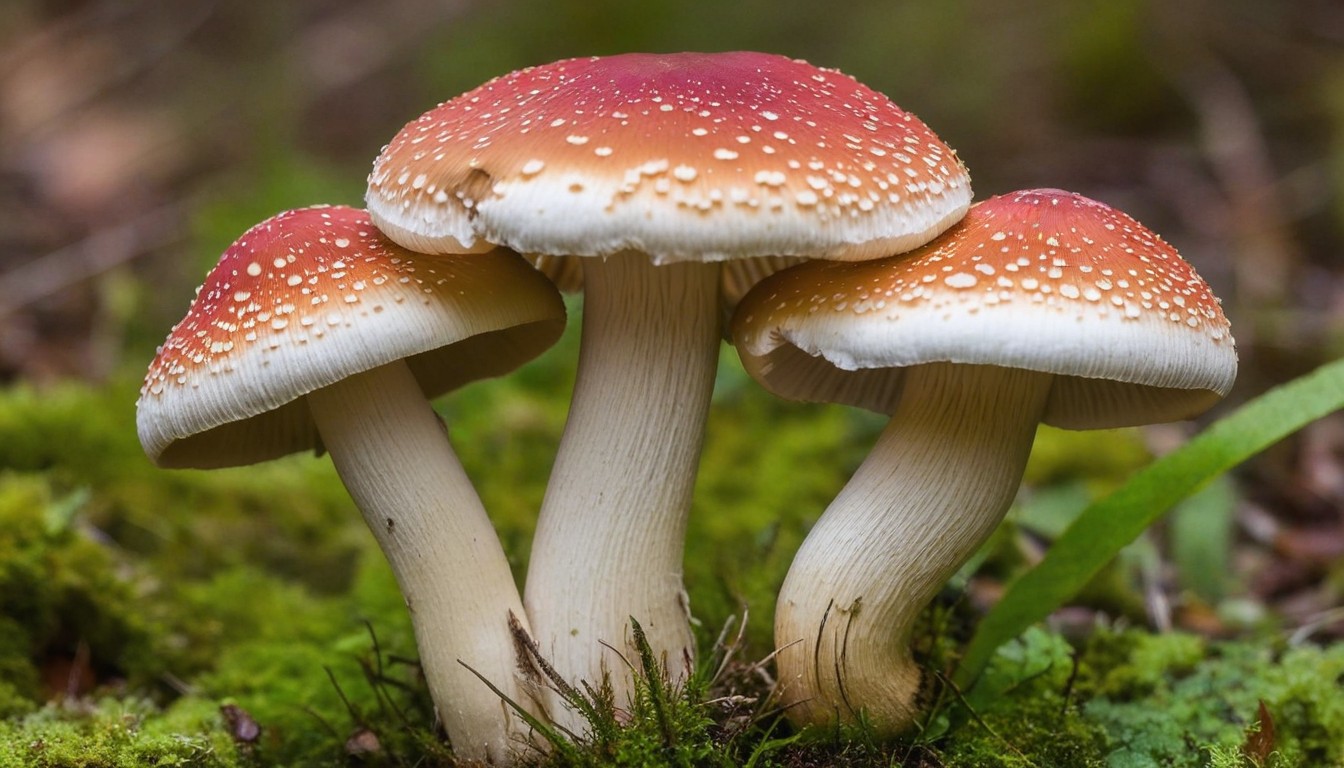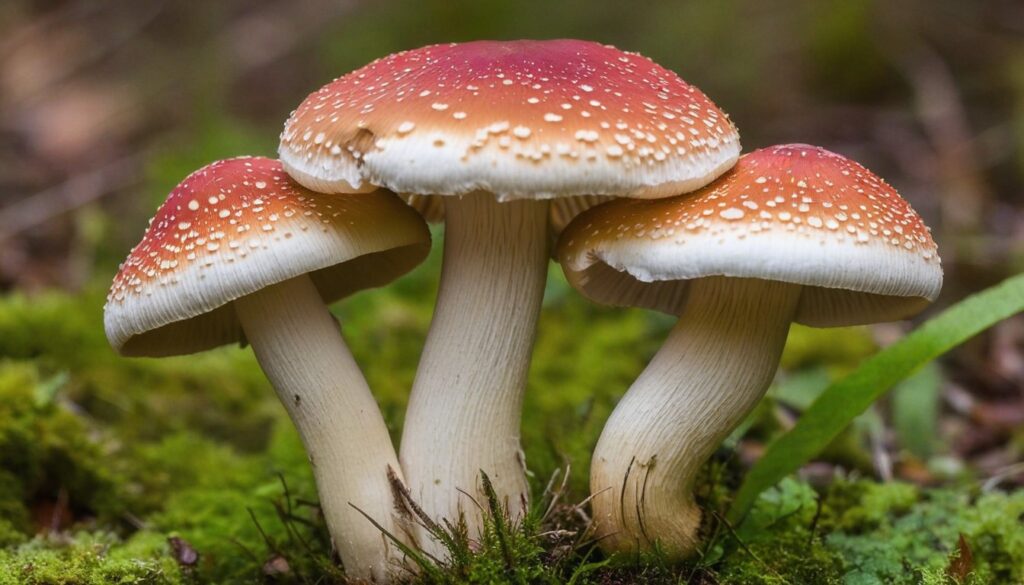Conjoined mushrooms, also known as “Siamese mushrooms”, are a fascinating and rare occurrence in nature. These unique fungi are characterized by their distinctive appearance, where two or more caps are fused together on a single stem, forming a conjoined structure.
While conjoined mushrooms are relatively uncommon, they can be found in various environments around the world, including forests, grasslands, and even in urban areas. Scientists and researchers continue to be intrigued by these mushrooms, studying their formation, function, and significance.
Key Takeaways:
- Conjoined mushrooms are a natural phenomenon characterized by two or more mushroom caps fused together on a single stem.
- These unique fungi are relatively rare but can be found in various environments around the world.
- Scientists continue to study conjoined mushrooms to better understand their formation, function, and ecological significance.
- Conjoined mushrooms have the potential to contribute to scientific research, medical applications, and culinary use.
- There are common misconceptions about conjoined mushrooms that need to be debunked.
What are Conjoined Mushrooms?
Conjoined mushrooms, as the name suggests, are fungi that are formed by the fusion or joining of two or more mushroom caps or stems. They are a rare and fascinating natural phenomenon that has been observed in various parts of the world, particularly in forests and other wooded areas.
These unique mushrooms can take on a variety of shapes and sizes, depending on which part of the mushroom has fused and how the fusion has occurred. Some conjoined mushrooms have separate caps that are joined at the stem, while others have entirely fused caps or stems. In some cases, the conjoined mushrooms may be asymmetrical, with one side of the mushroom larger than the other.
One of the most distinctive features of conjoined mushrooms is their often unusual appearance. They can be twisted, contorted, or otherwise distorted, making them stand out from other mushrooms in the surrounding area. They can also have unique color patterns, with contrasting colors or different shades of the same color appearing on different parts of the mushroom.
While the exact process of conjoined mushroom formation is not yet fully understood, it is thought to occur due to a combination of genetic mutations and environmental factors. When two or more mushrooms grow close together, their mycelia (the thread-like structures that make up the body of the mushroom) can intertwine and fuse, leading to the formation of conjoined mushrooms.
Conjoined mushrooms can also have different types of stems, from simple and thin, to sturdy and thick ones. Some of them have a stem that separates part of the mushroom from other parts, while others have fused stems. They can grow in different sizes, and their cap colors can vary from different shades of brown to white or yellow.
Conjoined mushrooms are often considered a fascinating sight in nature and are appreciated for their unique appearance. They are commonly found in forests and wooded areas across the world, primarily in temperate climates. Whether for scientific research or as a visual spectacle, conjoined mushrooms continue to captivate and intrigue us.
Types of Conjoined Mushrooms
Conjoined mushrooms come in various shapes and structures, making them fascinating to study and examine. Here are some of the most common types:
|
Type of Conjoined Mushroom |
Description |
|---|---|
|
Bi-cap conjoined mushrooms |
Two caps that are joined together with a single stem, creating a distinctive figure-eight shape. |
|
Fused stem conjoined mushrooms |
Multiple stems that fuse together near the base, with separate caps above each stem. |
|
Conjoined polypore mushrooms |
Polypore mushrooms with multiple caps and fused stems, often found growing on the sides of trees. |
|
Conjoined morels |
Distinctive mushrooms with a honeycombed cap that appears fused to another honeycomb structure. |
|
Siamese twin mushrooms |
Mushrooms fused together in a variety of ways, forming unique and sometimes abstract shapes. |
These are just a few examples of the many types of conjoined mushrooms that can be found in nature. Each type has its own distinct appearance and characteristics, making them a fascinating subject for researchers and lovers of the natural world alike.
Causes of Conjoined Mushroom Formation

Conjoined mushrooms are formed due to a combination of various factors. Genetic mutations, environmental conditions, and fungal interactions play a significant role in their formation.
Genetic mutations occur when the DNA of the mushroom is altered. This can happen naturally or due to exposure to certain chemicals or radiation. The mutated DNA can result in the abnormal growth patterns that cause conjoined mushrooms to form.
Environmental conditions such as temperature, humidity, and nutrient availability can also contribute to conjoined mushroom formation. For example, drought conditions can cause mushrooms to grow shorter and thicker, increasing the likelihood of conjoined growth.
Fungal interactions are another crucial factor in conjoined mushroom formation. Some fungal species have a symbiotic relationship, where one species benefits from the other, leading to co-growth. Other species compete for resources, leading to fusion and conjoined growth.
In summary, conjoined mushroom formation is a complex process influenced by genetic mutations, environmental conditions, and fungal interactions. Understanding these factors can help us appreciate the uniqueness of conjoined mushrooms and their significance in the natural world.
Conjoined Mushrooms in Nature
Conjoined mushrooms are a common sight in natural environments and play significant roles in many ecological processes. They can be found in forests, grasslands, wetlands, and even deserts, growing on dead wood, soil, and other decomposing organic matter. These mushrooms are often vital for nutrient cycling, helping to break down organic matter and release essential nutrients back into the ecosystem.
Moreover, conjoined mushrooms often form symbiotic relationships with other organisms, such as trees, plants, and animals. They may help plants absorb nutrients from the soil and protect them from harmful pathogens. Similarly, animals such as insects and mammals rely on conjoined mushrooms as a source of food and habitat.
Conjoined mushrooms also play an essential role in developing diverse and stable ecosystems. They help to bind soil particles together, preventing erosion and enhancing soil fertility, while also creating microhabitats for other organisms to thrive.
Examples of Conjoined Mushrooms in Nature
Bi-cap conjoined mushrooms, for instance, grow in clusters and are usually found on decaying logs, while fused stem conjoined mushrooms are usually found on the root of dying plants. There are also conjoined mushrooms that grow in fairy rings, forming a circle of mushrooms that indicate the presence of decaying organic matter beneath the soil.
The Ecological Significance of Conjoined Mushrooms
Conjoined mushrooms are crucial for maintaining a healthy and thriving ecosystem. They increase soil fertility, enhance biodiversity, and provide food and habitat for many organisms. Moreover, research indicates that the presence of conjoined mushrooms can act as an indicator of ecosystem health, helping to identify areas that may need protection or restoration.
Significance of Conjoined Mushrooms

Conjoined mushrooms have captured the attention of the scientific community and culinary world alike, with their unique features offering numerous potential benefits and contributions. Recent research has highlighted the potential medical applications of these mushrooms, including anti-cancer properties and immune system stimulation.
Furthermore, their symbiotic relationship with trees and other plants makes them an integral part of natural ecosystems, contributing to soil health and nutrient cycling. In addition, their distinctive shapes and structures have made them popular ingredients in gourmet cuisine, adding a unique flavor and texture to dishes.
Potential Benefits and Applications of Conjoined Mushrooms
|
Field |
Potential Benefits |
|---|---|
|
Medical Research |
Anti-cancer properties, immune system stimulation, potential treatment for neurological disorders |
|
Ecology |
Contribute to soil health, nutrient cycling, symbiotic relationships with other organisms |
|
Gastronomy |
Unique flavor and texture in dishes, popular gourmet ingredient |
With ongoing research and discoveries related to conjoined mushrooms, it is clear that these fungi hold significant potential for a range of fields and applications, from medicine to ecology to gastronomy.
Noteworthy Conjoined Mushroom Discoveries

Conjoined mushrooms continue to captivate researchers and enthusiasts alike with their curious forms and fascinating properties. Here, we explore some of the most noteworthy discoveries related to these unique fungi in recent years:
The Octopus Stinkhorn
One of the most unusual conjoined mushrooms ever discovered is the octopus stinkhorn, or Clathrus archeri. This rare species resembles an octopus in shape and texture, with a round, spongy body and long, branching arms. When mature, the octopus stinkhorn emits a putrid odor that attracts flies and other insects to disperse its spores.
|
Notable Feature |
Description |
|---|---|
|
Appearance |
Resembles an octopus in shape and texture, with a round, spongy body and long, branching arms. |
|
Odor |
Emits a putrid smell designed to attract flies and other insects for spore dispersal. |
|
Distribution |
Native to Australia and New Zealand, but has been found in other parts of the world. |
The Humongous Fungus
Another remarkable discovery in the world of conjoined mushrooms is the Armillaria ostoyae, also known as the Humongous Fungus. This massive organism covers over 2400 acres in Oregon’s Malheur National Forest, weighing over 400,000 pounds. Its intricate network of underground mycelial threads connects thousands of individual mushrooms, allowing them to communicate and share resources across vast distances.
“The Humongous Fungus demonstrates the incredible resilience and adaptability of fungi, as well as their critical role in forest ecosystems.” – Mycologist Paul Stamets
The Heart-Shaped Mushroom
One of the most visually striking conjoined mushrooms is the heart-shaped fungi, or Geastrum corazon. This unusual species resembles a pulsating heart, with a central sphere surrounded by several thin rays. When mature, the heart-shaped mushroom splits open to release a cloud of spores, which are dispersed by the wind.
The Parasitic Cordyceps
Perhaps the most infamous conjoined mushroom is the parasitic cordyceps, which infects and controls the behavior of insects. The Ophiocordyceps unilateralis fungus, for example, infiltrates the exoskeleton of ants and manipulates their actions, causing them to climb to a high point and attach themselves with their mandibles. The fungus then sprouts from the ant’s head, releasing spores that infect new hosts and continue the cycle of infection.
These and many other noteworthy conjoined mushroom discoveries continue to inspire wonder and awe among scientists and enthusiasts alike, urging us to appreciate the vast complexity and beauty of the natural world.
Myths and Misconceptions about Conjoined Mushrooms

Conjoined mushrooms have been the subject of many myths and misconceptions over the years. Despite their unique qualities and importance in the ecosystems they inhabit, these fascinating fungi are often misunderstood by the general public. In this section, we will dispel some of the most common myths and misconceptions about conjoined mushrooms.
Myth: Conjoined mushrooms are a result of genetic modification
Contrary to popular belief, conjoined mushrooms are not a result of genetic modification. Rather, they occur naturally, usually as a result of fungal interactions or environmental conditions. While some mutations may contribute to the formation of conjoined mushrooms, they are not the primary cause.
Myth: Conjoined mushrooms are poisonous
There is no evidence to suggest that conjoined mushrooms are more poisonous than their non-conjoined counterparts. In fact, many species of conjoined mushrooms are edible and have been used for culinary purposes for centuries.
Myth: Conjoined mushrooms are rare and exotic
While some species of conjoined mushrooms are rare and difficult to find, many others are common and can be found in a variety of environments. While they may be unusual in appearance, conjoined mushrooms are not necessarily exotic in the true sense of the word.
Misconception: Conjoined mushrooms are a form of parasitism
Although conjoined mushrooms may appear to be parasitic, they are not necessarily harmful to the fungi they are attached to. In many cases, conjoined mushrooms form as a result of mutualistic relationships between fungal species, wherein each benefits from the other’s presence.
Myth: Conjoined mushrooms are a sign of fungal disease
While some types of conjoined mushrooms may be a sign of fungal disease or decay, this is not true for all species. Conjoined mushrooms can form for a variety of reasons, and should not be automatically assumed to be a sign of disease or decay.
“Misconceptions about conjoined mushrooms are common, but with a bit of understanding, we can appreciate these fascinating fungi for what they are. Let’s dispel these myths and embrace the uniqueness of conjoined mushrooms.”
Conjoined Mushrooms and the Environment
Conjoined mushrooms play a vital role in maintaining a healthy and stable environment. These unique organisms contribute significantly to biodiversity and ecological interactions. They are essential to soil health as they help recycle nutrients and decompose organic matter, making them available for other organisms to use.
Conjoined mushrooms also have a symbiotic relationship with other plants and trees, providing them with essential nutrients and aiding in their growth. In some instances, they are even known to protect plants from stress and disease.
Moreover, certain types of conjoined mushrooms have been found to have medicinal properties. They produce compounds that have anti-inflammatory and antioxidant effects, making them potentially useful in treating various health conditions.
The significance of conjoined mushrooms in preserving the environment cannot be overstated. Thus, efforts to conserve these organisms and their habitats are essential to maintaining a healthy and stable ecosystem.
The Role of Conjoined Mushrooms in Biodiversity
To understand the ecological impact of conjoined mushrooms, it is essential to consider their contributions to biodiversity. Conjoined mushrooms provide a habitat and source of food for various organisms, ranging from insects and small mammals, to other fungi and bacteria.
They also play a crucial role in decomposing dead plant and animal matter, recycling nutrients in the soil, and facilitating the growth of new life. Healthy soil ecosystems, sustained by the presence of conjoined mushrooms, help regulate the climate and maintain the equilibrium of the environment.
Studying Conjoined Mushrooms: Research and Discoveries
Conjoined mushrooms have captured the attention of scientists and researchers worldwide. As a unique natural phenomenon, scientists have been studying them to unlock important secrets about the fungal kingdom, including their genetics, ecology, and potential medicinal properties.
Recent research has shown that conjoined mushrooms can reveal fascinating information about fungal development and interactions. For example, scientists have discovered that conjoined mushrooms can emerge from the same mycelial network, suggesting that they may share nutrients and resources.
Another discovery has been the identification of rare and previously unknown species of conjoined mushrooms, expanding our knowledge of the fungal kingdom. Researchers are also exploring the effects of environmental factors on the formation and growth of conjoined mushrooms, providing new insights into the ecology of fungal communities.
Furthermore, ongoing studies on the medicinal properties of conjoined mushrooms have shown promising results. Research has suggested that conjoined mushrooms may have anti-cancer, anti-inflammatory, and immune-boosting properties, making them a potential therapeutic option in the future.
The study of conjoined mushrooms continues to provide exciting discoveries and insights that could have far-reaching implications. With its multifaceted nature and unique characteristics, conjoined mushrooms are truly a natural spectacle worth exploring.
Conclusion
Conjoined mushrooms are indeed a fascinating and unique natural phenomenon that has captured the attention of scientists, researchers, and mushroom enthusiasts alike. From their distinctive shapes and structures to their significant contributions to the environment, there is much to explore and discover about these intriguing fungi.
Through this article, we have delved into the various aspects of conjoined mushrooms, including their formation, types, causes, significance, and ecological impact. We have also explored some noteworthy discoveries related to conjoined mushrooms and addressed common myths and misconceptions surrounding them.
Overall, the study of conjoined mushrooms is a field that continues to offer exciting new insights and discoveries. As researchers and scientists continue to unravel their mysteries, we can expect to learn more about how these fascinating fungi contribute to the natural world and our understanding of it.
FAQ
What are Conjoined Mushrooms?
Conjoined mushrooms are a unique phenomenon where two or more mushroom caps or stems grow together, resulting in a fused or joined appearance. These mushrooms are characterized by their distinct shape and structure.
What are the types of Conjoined Mushrooms?
There are various types of conjoined mushrooms, including bi-cap conjoined mushrooms, where two caps are fused together, and fused stem conjoined mushrooms, where two or more stems grow together and merge. Other types include branched conjoined mushrooms and conjoined mushrooms with multiple caps.
What causes Conjoined Mushroom formation?
Conjoined mushroom formation can be attributed to several factors, including genetic mutations within the mushroom spores, environmental conditions, and interactions between different fungi. These factors contribute to the fusion and growth of conjoined mushrooms.
Where can Conjoined Mushrooms be found in nature?
Conjoined mushrooms can be found in various natural ecosystems, including forests, grasslands, and wetlands. They play important roles in nutrient cycling, symbiotic relationships with other organisms, and ecological interactions.
What is the significance of Conjoined Mushrooms?
Conjoined mushrooms have significance in scientific research, medical applications, and culinary use. They offer potential benefits in areas such as identifying genetic mutations, exploring fungal interactions, and adding unique flavors to culinary dishes.
Are there any noteworthy discoveries related to Conjoined Mushrooms?
Yes, there have been several remarkable discoveries related to conjoined mushrooms. These include the identification of rare species, unique formations of conjoined mushrooms, and unexpected occurrences in different parts of the world.
What are some myths and misconceptions about Conjoined Mushrooms?
There are common myths and misconceptions surrounding conjoined mushrooms, such as their toxicity or harmful effects on the environment. However, scientific evidence shows that conjoined mushrooms are generally safe and have positive ecological contributions.
How do Conjoined Mushrooms impact the environment?
Conjoined mushrooms contribute to the environment by enhancing biodiversity, promoting ecosystem stability, and improving soil health. They play a role in nutrient cycling and form beneficial relationships with other organisms in their ecosystem.
What research has been done on Conjoined Mushrooms?
There is ongoing scientific research and discoveries related to conjoined mushrooms. Researchers study their genetic makeup, investigate their ecological roles, and explore potential applications in various fields, such as medicine and agriculture.

